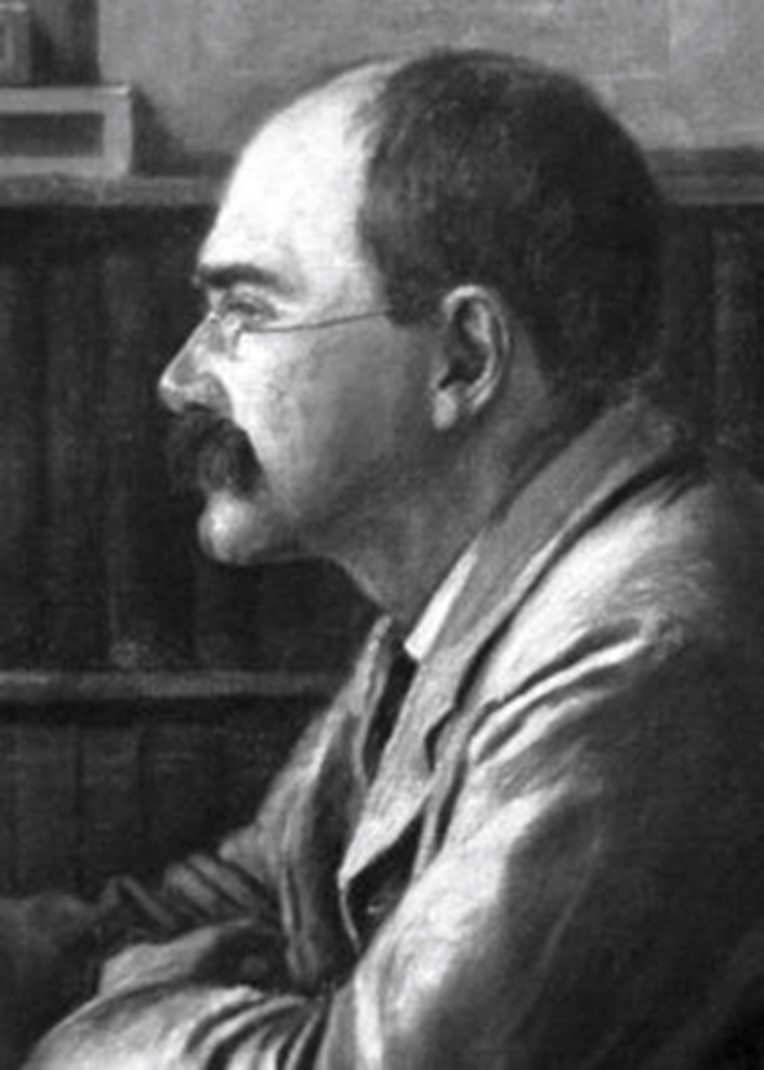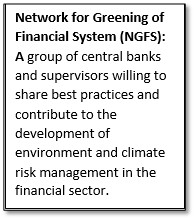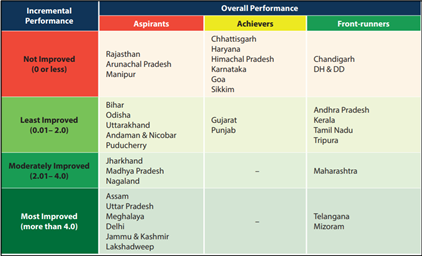Tuesday, 4th January 2022
Infrastructure build-up on the Line of Actual Control (LAC)
In News
New satellite image shows China constructing bridge on its side of Pangong lake in the Khurnak area.
About the News
- The armies of India and China had created a buffer zone in Galwan valley following their deadly clashes on June 15, 2020.
- As per reports, the bridge is being constructed at a distance of around 40 km from the alignment of the LAC in the region and connects the North and South banks of Pangong lake.
- As per Military experts, the aim of constructing the bridge in the Khurnak area could be to ensure that the Chinese People's Liberation Army (PLA) is able to quickly mobilise its troops in the region.

Chinese Infrastructure near LAC
China has been strengthening its military infrastructure after Indian troops took control of several strategic peaks on the southern bank of Pangong lake in August 2020 after Chinese incursion.
According to reports
- The PLA has built at least eight roads towards the LAC from China’s G219 highway. These run from the salt water lake Tianshuihai in the Xinjiang region towards Galwan valley and from Kangxiwar in China’s southwestern Xinjiang region to the Karakoram Pass. Connecting roads have also been constructed north-south along these lateral roads.
- The Chinese were also constructing new airstrips apart from the main bases in Kashgar, Gar Gunsa and Hotan.
- Heliports were being constructed along the border in Xaidulla, Tianshuihai, Shiquanhe and Domar regions.
- China’s civilian settlements: Beijing has established multiple residential 'villages' close to the LAC between India and China. In November 2021, China had constructed a cluster of at least 60 buildings inside Arunachal Pradesh. According to reports, this 'village' was six kilometres within India in the region between the LAC and the International Boundary.
India too ramps up infra
Upgradation and development of infrastructure along the Northern Borders are being carried out in a holistic and comprehensive manner, including roads, tunnels for all-weather connectivity, four Strategic railway lines, additional bridges across the Brahmaputra, up-gradation of bridges on critical Indo-China border roads, and storage for supplies, fuel, and ammunition. Major efforts have also been undertaken to identify dual-use infrastructure.
- The Defence ministry has launched five major road projects in Ladakh by the Border Roads Organisation (BRO), including the Hanuthang-Handanbroke-Zungpal-Turtuk road between the Indus valley and the Shyok valley.
- The BRO will also build a connecting road from Pooh in Himachal Pradesh to Chumar in Ladakh. It will also complete an alternate road for Daulat Beg Oldie (DBO) from Sasoma connecting Saser La and Gapshan and merging with the existing route to DBO.
- Recently inaugurated is the Chisumle-Demchok road at Umling La Pass at over 19,000 feet in Ladakh that is considered as a key stretch for military purpose.
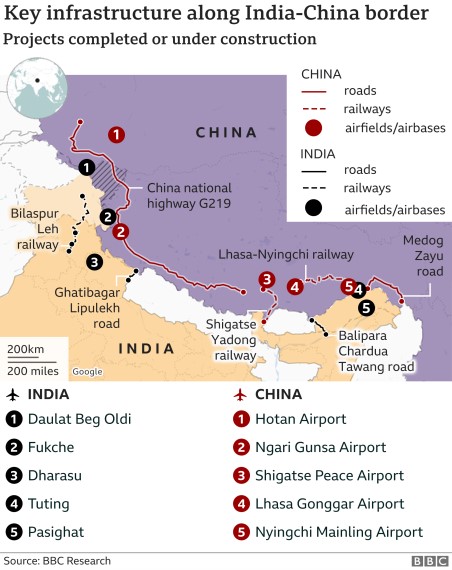
India’s concerns
- The current ongoing additional road constructions and upgradation of existing roads will ensure that China will have direct road connectivity to areas opposite important Indian military posts along the LAC, from DBO in the north to Galwan valley, Pangong tso and Chumar in the south.
- India communicated its concerns over the infrastructure build-up to Beijing in the latest Working Mechanism for Consultation and Coordination of India-China Border Affairs meeting.
Sources:
- East of LAC, China builds new bridge on Pangong Tso
- China-India border: PLA ramps up infrastructure along LAC, say reports
- India-China border standoff: China constructs bridge on Pangong lake in Ladakh
- New satellite images show China building bridge along Pangong Tso: A look at Beijing's infrastructure build-up along LAC
- LAC: India and China accelerate several infrastructure projects
- India and China race to build along a disputed frontier
- China-India border dispute: New Delhi talks up infrastructure build-up in strategy shift against Beijing
- China and India’s Border Infrastructure Race
Shelf life of Covid-19 vaccines
In News
After receiving approval from CDSCO, the maker of Covaxin- Bharat Biotech has started lifting unused stock from hospitals to re-label the shelf life.
About the News
- An estimated 20 crore vaccine doses are required to fully vaccinate the nearly 10 crore people in the 15-18 age group.
- Covid-19 vaccine shelf lives have been extended from time to time by the Drugs Controller General of India (DCGI) based on stability data generated and submitted by the manufacturers.
- The shelf-life of Covaxin, has been extended from 9 to 12 months from the date of manufacture.
- With the shelf-life extension hospitals have been allowed to utilise the stock which was nearing the expiry to avoid vaccine wastage.
- The anxiety arose after several people pointed out that vaccine batches that were supposed to expire in November were being administered to the younger people recently.
- Ministry of Health has clarified that the shelf life of vaccines was extended based on comprehensive analysis and examination of “stability data” furnished by the vaccine manufacturers.
Why has the shelf-life of Covaxin been extended?
- An opened vial of Covaxin can be stored at 2-8 degree Celsius for up to 28 days and is not required to be discarded immediately in a day or at the end of immunisation session.
- With the shelf-life extension, hospitals could utilise the stock that was nearing expiry and avoid vaccine wastage.
What are ‘stability’ and ‘shelf life’ of a vaccine?
- Stability: According to the World Health Organization (WHO), stability is the ability of a vaccine to retain its chemical, physical, microbiological and biological properties within specified limits throughout its shelf life.
- Shelf-life: Vaccines come with a date of expiry and shelf life and its constituents can go bad over time because of slow chemical reactions and lose efficacy.
- Stability studies are done to determine shelf life and storage conditions, monitor vaccine stability in the post-licensure period and support manufacturing changes by demonstrating comparability of product manufactured by different processes.
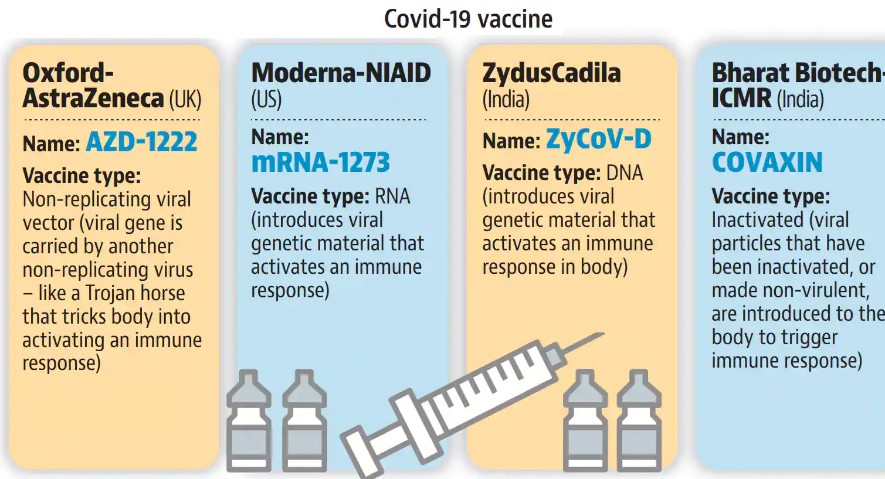
How is shelf life calculated?
- Shelf life is calculated by storing the product at different temperatures for various lengths of time and then testing its effectiveness.
- By storing the particular product at various temperatures, and then periodically checking if there is any degradation of the product, an expiry date is arrived at.
- The duration over which the product is stable and effective in the specified conditions is considered its shelf life.
Sources:
Green Hydrogen blending with Natural gas
In News
The government is planning to blend 15 per cent green hydrogen with piped natural gas (PNG) for domestic, commercial and industrial consumption.
About the News
- This initiative will be part of the government’s National Hydrogen Energy Mission aimed at generating hydrogen from green power sources. It aims to develop India into a global hub for manufacturing hydrogen and fuel cell technologies across the value chain.
- Government plans to float bids for manufacturing green hydrogen, which will be supplied to fertiliser units and petroleum refineries.
- There is also plan to supply green hydrogen for PNG. The government will offer free transmission (of power) for this like in the case of RE. The objective is to blend 15 per cent green hydrogen with PNG, as it is technically viable. Beyond this, the gas pipeline would have to be refurbished.
- Hydrogen purchase obligation (HPO) will be created, similar to Renewable Purchase Obligations, to cover industries like oil refineries and fertiliser plants, which use grey hydrogen. The idea is to create demand for green hydrogen.
- Renewable Purchase Obligation (RPO) mandates that all electricity distribution licensees should purchase or produce a minimum specified quantity of their requirements from Renewable Energy Sources. This is as per the Indian Electricity Act, 2003.
- The plan of Hydrogen blending is in line with India’s ambitious targets for reducing greenhouse gas emissions and becoming carbon neutral by 2070.
- Hydrogen produced can be injected into natural gas pipelines, and the resulting blends can be used to generate heat and power with lower emissions than using natural gas alone.
Advantages of Blending Hydrogen
- Energy Carrier: Hydrogen is a flexible energy carrier and can be used for many energy applications like integration of renewables and transportation.
- Ease of Transportation: Gaseous hydrogen can be transported through pipelines much the way natural gas is today.
- Low cost: Transporting gaseous hydrogen via existing pipelines is a low-cost option for delivering large volumes of hydrogen.
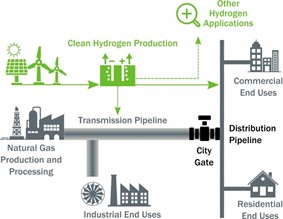
Challenges associated with using Hydrogen in Pipeline
- Effect on Pipelines: Hydrogen affects the pipelines it travels in and appliances that use it. On the pipeline front, hydrogen embrittlement can weaken metal or polyethylene pipes and increase leakage risks, particularly in high-pressure pipes.
- Hydrogen embrittlement is a situation when the metal (pipeline) becomes brittle due to diffusion of hydrogen into the material. The extent of embrittlement depends on the amount of hydrogen and the material’s microstructure.
- Need for constant monitoring: There is also need to control hydrogen permeation and leaks.
- Hydrogen compression technology, in the current state is expensive and unreliable. There is need for lower cost, more reliable, and more durable technology.
Source:
- Govt planning to blend 15 per cent green hydrogen with piped natural gas
- Govt planning to blend 15 per cent green hydrogen with piped natural gas
Image Source:
World Braille Day
On January 4, 1809 Louis Braille, the man who invented braille was born. World Braille Day commemorates the birth anniversary of Louis Braille. Braille is a form of written language for blind people, in which characters are represented by patterns of raised dots that are felt with the fingertips. World Braille Day is observed every year to create awareness of the importance of braille as a means of communication in the full realization of the human rights for blind and visually impaired people. Louis Braille was a French educator. His system still remains the most widely used medium of reading for blind people around the world. Louis Braille was blinded in one eye at the age of three after an accident with a stitching awl in his father's harness-making shop. He invented braille which, ironically, used an awl-like stylus to punch marks in the paper that could be felt and interpreted by blind people. Braille was essentially a representation of alphabetic and numerical symbols using six dots to represent each letter and number. Historically, the system is based on a tactile military code called night writing that was developed by Charles Barbier in response to Napoleon's demand for a means for soldiers to communicate silently at night without any source of light.

Source:
Farmer Producer Organizations: The State of India's Livelihoods (SOIL) Report, 2021
In News
As per the State of India’s Livelihood (SOIL) Report 2021, only 1-5 per cent of FPOs have received funding under central government schemes introduced to promote them in the last seven years.
What are Farmer Producer Organizations?
- FPOs are collective enterprises formed by farmers (primarily rural producers) to enable better connect between market and rural agricultural produce. FPOs are the latest addition to the family of cooperatives organisations and the verdict on their success is still awaited.
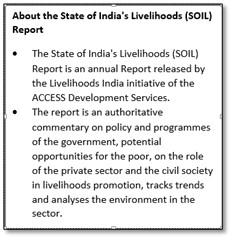
- Through the Farmer Producer Organizations (FPO) farmers can register themselves under the Indian Companies Act.
- To facilitate the process, the Small Farmers Agribusiness Consortium (SFAC) was mandated by the Department of Agriculture and Cooperation, Ministry of Agriculture, Govt. of India, to support the State Government in the formation of the Farmer Producer Organizations (FPOs).
- As of March 2019, there were over 7000 FPOs or Producer Companies (PCs) registered in India since the introduction of the Companies Act, a period of 16 financial years.
- Farmer Producer Organization is promoted under “One District One Product” to promote the specialization and better branding, marketing, processing and exports by FPO.
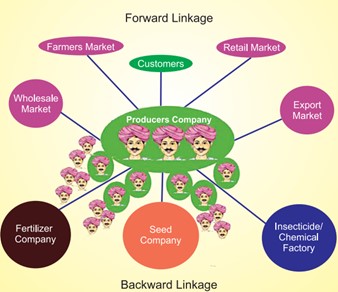
How do FPOs benefit the farmers?
- Ensure Economies of Scale: The main aim of the Farmer Producer Organization is to ensure a better income for the producers through an organization of their own. Small producers do not have the volume individually to get the benefit of economies of scale.
- Bargaining Power: Farmers Producers have better bargaining power in the form of bulk buyers of produce and bulk suppliers of inputs.
- Aggregator of Resources: The role of FPO is to act as an aggregator for member farmers including from inputs to output. In case of unsold Lots, Logisitics arrangement is to be made by FPO/FPC.
- Vertical Integration: FPOs have the potential to bring about vertical integration in the traditional fragmented supply chains with need-based long term business plans.
- FPOs also create opportunities for producers to get involved in value all supply chain activities such as input supply, credit, processing, marketing and distribution.
- Farmers’ competitiveness: FPOs aim to enhance the farmers’ competitiveness and to increase their advantage in emerging the market opportunities.
- End-to-end support: Farmers Producers Organization provides end-to-end support and services to the small farmers, and cover technical services, marketing, processing, and others aspects of cultivation inputs.
- Reduce Vulnerabilities: Collectives can also reduce risk and vulnerabilities of members, as was observed in the case of many peri-urban FPOs which were able to continue operations during COVID-19 lockdown, a feat which would have been very difficult for small individual producers.
- Social Equity: In cases where collectives also become established as local institutions, they have the potential to significantly contribute to improvements in social equity as well.
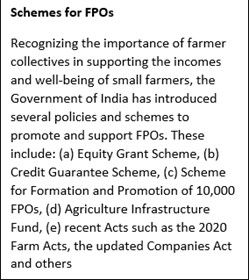
What are the Challenges related to FPOs?
- Geographical Disparity: There is geographical concentration in registration of FPOs in certain regions, leaving out the most disadvantaged groups and regions, such as aspirational districts. The inclusion of women in PCs continues to be minimal. This runs counter to the purpose of the policies established to support PCs.
- Capitalization Issue: PCs continue to find it difficult to raise working capital and long-term debt due to weak balance sheets and have a limited track record of achieving stability and success. Very few PCs have been able to avail of the Equity Grant and Credit Guarantee Schemes in the last seven years.
- Funding Issue: There is very limited direct funding for FPOs in the 10,000 FPO Scheme. The bulk of the direct funding for FPOs is in the form of Equity Grant and Credit Guarantee Schemes which very few PCs are able to avail.
- Lack of Business Acumen: FPOs clearly demonstrate the need for strengthening the business acumen and expertise. Only companies started by larger, well-educated and well-connected farmers appear to be able to overcome this hurdle, while most of those focused on small producers continue to struggle.
- Unsuitable Operating Models: Despite the policy recommending a federated model of promotion, majority of FPOs continue to be promoted in a standalone model. Furthermore, very few promoting institutions are attempting multi-commodity and multi-layer operating models, such as the two-tier model, thus requiring each company to fend for itself.
- Weak Shareholder Protection: Small and marginal producers tend to be less educated and have limited understanding of companies as legal entities and lack awareness about their rights and responsibilities as shareholders. This makes them vulnerable to intentional fraud or unintentional mismanagement and negligence.
- Differences in Normative Imagination: Small producers do not view themselves as owners of FPOs, but rather as commodity suppliers and beneficiaries. Most of them imagine FPOs as non-exploitative buyers and service providers, as part of welfare interventions of NGOs or governments.
- On the other hand, most socially minded promoting institutions (e.g., NGOs) and government departments view FPCs as vehicles for pooling beneficiaries under their welfare initiatives. Some promoting institutions and large farmers see FPCs primarily as for-profit business entities. These differences in imaginations result in differences in priorities.
Way Forward
- Increase in Coverage: Coverage and inclusion of small and marginal farmers in FPOs should be one of the main priorities of any program for promotion. Such a focus would ensure that producers in aspirational districts, rainfed areas and/or predominantly Adivasi areas have the opportunity to benefit from collectivization and government mechanisms for supporting PCs. It is equally important to increase the proportion of women-only PCs.
- Appropriate Business Model: Selection suitable operating models (e.g., federated and two-tiered) depending on the commodities and the local context needs to be prioritised. For example, while a stand-alone model may be suitable for some peri-urban PCs focusing on sales of fresh organic vegetables, this model would be inappropriate for most PCs in remote areas. Thus, choice of an appropriate operating model is key for enabling business success.
- New Investment Avenues: Currently the Companies Act does not allow PCs to receive investment from non-producers. It may be good to consider modifying the provisions in the Act to allow limited external investments while protecting small producers’ interests (e.g., through different class of nonvoting shares and other mechanisms).
Conclusion: While FPOs continue to face several setbacks and are struggling to operate viably in many countries, continued support from governments and other organisations can ensure their sustainability in the long run. Their survival and prosperity are also highly crucial to bring about transformation in the food and agriculture sector in developing and underdeveloped countries, which is imperative to guarantee food security for future generations. With the implementation of the right policies, and with the support of all actors in the ecosystem, FPOs will soon be able to achieve sustainability and reap optimal benefits for its shareholders.
Question: Discuss the importance of FPOs in welfare of Farmers and the challneges faced by FPOs in achieving its objectives.
Sources:
George Wittet
This is image of George Wittet, who has designed some of the famous architectural heritage buildings in Mumbai. The beautiful Grade 1 heritage building Chhatrapati Shivaji Maharaj Vastu Sangrahalaya (CSMVS) in Mumbai was designed by George Wittet (1878-1926), who was consulting architect to the Government of Bombay in the early 20th century. Besides the Prince of Wales Museum of Western India, the name by which CSMVS was originally known, Wittet also designed the Gateway of India, both fine examples of Indo-Saracenic architecture and among the most identifiable landmarks of Mumbai. He along with John Begg, pioneered the Indo-Saracenic style, using it in several government and public buildings across Bombay. He was also elected as the first president of The Indian Institute of Architects. The Indo-Saracenic style was promoted by British architects starting from the late 19th century. It is exemplified by the use of elements seen in architecture across India, from Mughal structures to Hindu temples. The style was dominated by Indo-Islamic elements, but sometimes combined with Gothic and neo-classical elements popular in Britain at that time. Indo-Saracenic was seen as the Raj’s efforts to promote “Indian” culture, so that their colonial subjects would view them more favourably, especially after the Revolt of 1857.

Source:
Cyber Security breach at GitHub
- Context: GitHub platform was used to create and share an offensively that sexually harassed Muslim women in India through pictures of the women stolen from their social media.
- GitHub has blocked the user, and the Indian Computer Emergency Response System (Cert-In), the nodal agency for monitoring cyber security incidents, has been asked to form “a high-level committee” to investigate.
- GitHub is the world’s largest open-source developer community platform where users upload their projects and code for others to view, edit, and tweak.
- The idea of GitHub is that any developer can upload whatever software code or app code or software idea they have on the platform, and have others collaborate with them to help improve it, find errors, and fix problems.
- The platform uses the software Git, to track changes in a set of files and for coordination in software development.
- After having been acquired by Microsoft in 2018, GitHub has expanded its presence in newer markets such as India, where there are millions of developers.

Source:
‘Padhe Bharat’ campaign
- Context: The government has recently launched the ‘Padhe Bharat’ campaign.
- Padhe Bharat is a 100-day reading campaign initiating from January 1,2022 to April 10, 2022 on account of new year resolution.
- The campaign will also focus on regional languages, promoting indigenization with cultured education in our society.
- On similar lines, 21st February which is celebrated as International Mother Tongue Day is also integrated with the campaign- of ‘Kahani Padho Apni Bhasa Main’ (Reading story in own language).
- The campaign aims to enhance the learning levels of students as it develops analytical thinking, and the ability to practice in real-life situations.
- The campaign will target the students studying in Balvatika to Grade 8. It ensures the wholesome participation of all stakeholders from the national and state level educational institute including children, teachers, parents, community, and educational administrators.
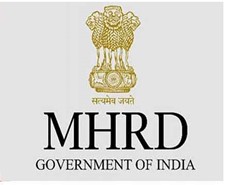
Source:
Chisumle-Demchok road sets a Guinness World record
- Context: Recently inaugurated Chisumle-Demchok road (Eastern Ladakh) holds the Guinness World Record of world's as the highest motorable road,
- It passes through the Umling La pass situated at an elevation of 19,000 feet.
- The black-topped, 52-kilometre road connects many important towns in the Chumar sector of Eastern Ladakh.
- The project to build the road through the pass is a part of BRO’s Project Himank. This road is much above the altitude of Siachen Glacier which is at 17,700 feet.
- The road will play a major role in the future to boost the socio-economic status of local residents, especially of the people of the Lalok region of Ladakh.
- Tourists will be able to see the world's highest motorable road, rare medicinal plants, participate in snow sport activities, see nomadic livestock, lakes and other attractions.
- It is located at a very strategic point as the villages that will be connected by the road are very close to the India-China border in the eastern sector. This road was constructed under Project Himank.
- This road is much above the altitude of Siachen Glacier which is at 17,700 feet.
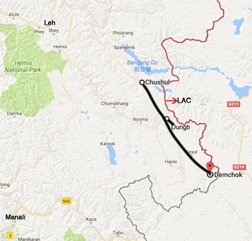
Source:
Image Source:
China Renames 15 Places in Arunachal Pradesh
- Context: China has recently altered the name of 15 places in Arunachal Pradesh claiming the state as South Tibet.
- This follows China’s 2017 attempt of assigning such names to places in the State.
- Of the 15 places, eight are residential places, four are mountains, two are rivers and one is a mountain pass.
- China’s persistent policy of renaming places is a result of China claiming that it did not consent to the Simla Convention 1914.
- According to them Tibet did not have independent authority to enter into an International agreement being a part of Chinese territory.
- India has however asserted that Arunachal Pradesh has "always been" and will "always be" an integral part of India and that assigning "invented" names does not alter this fact.
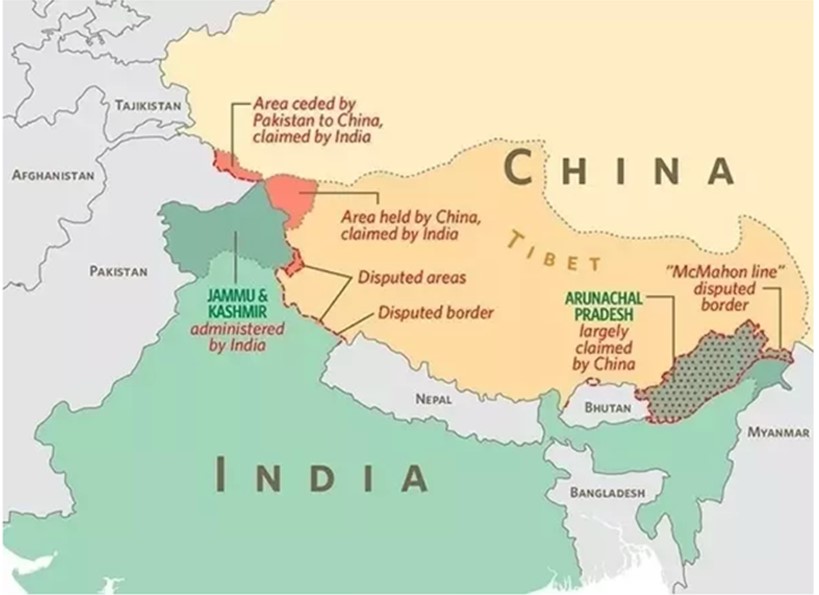

Source:
- https://economictimes.indiatimes.com/news/defence/china-says-arunachal-pradesh-inherent-part-of-its-territory/articleshow/88612121.cms?from=mdr
- https://www.deccanherald.com/national/chinas-settlements-renaming-aimed-to-gain-edge-in-border-talks-1066765.html
- https://www.tandfonline.com/doi/abs/10.1080/03068376708731991?journalCode=raaf19
Image Source:
How to optimise service delivery in the urban sector: HT
Essence: The urban sector is seeing a rise in investment and simultaneous need of Public-Private Community Partnership (PPCP) in building sustainable cities. Efficient urban management requires all the stakeholders to join hands. But this sector is not untouched by challenges like trust deficit, disrupted investments etc. The importance of PPCP is increasing with the increasing importance of digital technology.
To encourage healthy and greater partnership between public and private sectors central government has been taking many steps like scaling up the SHGs to urban areas using Smart Cities Advisory Forum etc. The articles suggest various steps for success of community participation at local level like community awareness, use of NGOs and CSOs, creating army of city volunteers etc. PPCP will ensure good governance and economic growth of urban centres.
Why to read this article?
- To understand the importance of Public-Private Community Partnership (PPCP) in economic growth of urban centres.
- Good Governance in the Urban Sector, its financial resources and stakeholders are important areas to study for both GS II and GS III.
Source:
MSMEs: Engines of growth for new India: HBL
Essence: The article talks about the factors that are inhibiting India from reaping the benefits of MSME sector. Lack of information, technological obsolescence, negligible market linkages, absence of exit policy, etc. are the factors that inhibit MSME’s to reach its full potential. Along with these issues, the companies suffer from lack of collaterals, which compels them to rely on unsecured loans.
In order to reap the full benefits of Special Credit Linked Capital Subsidy Scheme the government should focus on providing ease of access to factors of production along with promoting export of services. Even the MSMEs should be trained to use digital channels like TReDS so that speedy recoveries could be made. Indian government should realize that policy support is necessary so that MSME could be made engines of growth to achieve the goal of self- reliant India.
Why you should read this article?
- To understand why MSME’s are termed as growth engines of India.
- To understand the factors that is inhibiting India from realizing its potential.
- To understand the steps that should be taken by the government so that they can reap the benefits of MSME in India’s growth.
Source:
What lessons does Ukraine offer South Asia?: IE
Essence: The editorial focuses on the concept of “spheres of influence” of major powers in the international relations. The context of discussion arrives from the US-Russia meeting, due to be held next week on the influence of NATO on Ukraine and spread of western influence in Eastern Europe. Russia is concerned as Soviet-led Warsaw Pact ceased to exist in 1991, but NATO grew its influence in Russia’s neighborhood. Due to this, Russia had to intervene, especially in Georgia and Ukraine, despite the idea of “Common European Home”.
The sphere of influence has been historically opposed by Asian powers due to them being at the receiving end of European imperialism in the 19th and 20th century. But, in reality, major powers in Asia do exert such influence under the garb of “Asia for Asians, like Japan or China. India received the vast Indian ocean region and the sub-continent , as inheritance from British, where it tries to maintain its influence. Even though Indian economy is far smaller than Chinese economy, India will apply all means to establish a stronger legitimacy and force with the nearby regions, similar to how Russia operates with European Union.
Why you should read this article?
- To understand the concept of sphere of influence in international politics.
- To find relevant examples of countries setting up their spheres of influence.
Source:
Eliminating Caste discrimination
Background
- Indian Caste hierarchy is one of the major reasons for this perpetual difference in socio-economic status. India has been ranked 129 among 158 countries in the 2020 Commitment to Reducing Inequality (CRI) Index.
- Dalits in Anugonda village of Kodumuru mandal in Kurnool district, who were restricted from entering barbershop, temples etc. protested against this discrimination.
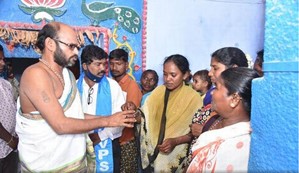
March against Untouchability:
- The protest was held in the wake of an attack on a Dalit youth, who was assaulted and thrown out of a barbershop where he had gone to get a haircut.
- The Dalit community marched to a temple and raised slogans against untouchabilty and marched through the village streets, supported by activists.
- As a symbol to eliminate discrimination, the protestors set foot into temple for the first time and offered prayers to the deity.
- The leaders of the protest asked the villagers to not bow before anyone and stop following the wrong practices like discrimination.
Quote:
“Caste system does not demarcate racial division. Caste system is a social division of people of the same race.”: Dr. B.R. Ambedkar
Source:
Share the article
Get Latest Updates on Offers, Event dates, and free Mentorship sessions.

Get in touch with our Expert Academic Counsellors 👋
FAQs
UPSC Daily Current Affairs focuses on learning current events on a daily basis. An aspirant needs to study regular and updated information about current events, news, and relevant topics that are important for UPSC aspirants. It covers national and international affairs, government policies, socio-economic issues, science and technology advancements, and more.
UPSC Daily Current Affairs provides aspirants with a concise and comprehensive overview of the latest happenings and developments across various fields. It helps aspirants stay updated with current affairs and provides them with valuable insights and analysis, which are essential for answering questions in the UPSC examinations. It enhances their knowledge, analytical skills, and ability to connect current affairs with the UPSC syllabus.
UPSC Daily Current Affairs covers a wide range of topics, including politics, economics, science and technology, environment, social issues, governance, international relations, and more. It offers news summaries, in-depth analyses, editorials, opinion pieces, and relevant study materials. It also provides practice questions and quizzes to help aspirants test their understanding of current affairs.
Edukemy's UPSC Daily Current Affairs can be accessed through:
- UPSC Daily Current Affairs can be accessed through Current Affairs tab at the top of the Main Page of Edukemy.
- Edukemy Mobile app: The Daily Current Affairs can also be access through Edukemy Mobile App.
- Social media: Follow Edukemy’s official social media accounts or pages that provide UPSC Daily Current Affairs updates, including Facebook, Twitter, or Telegram channels.


